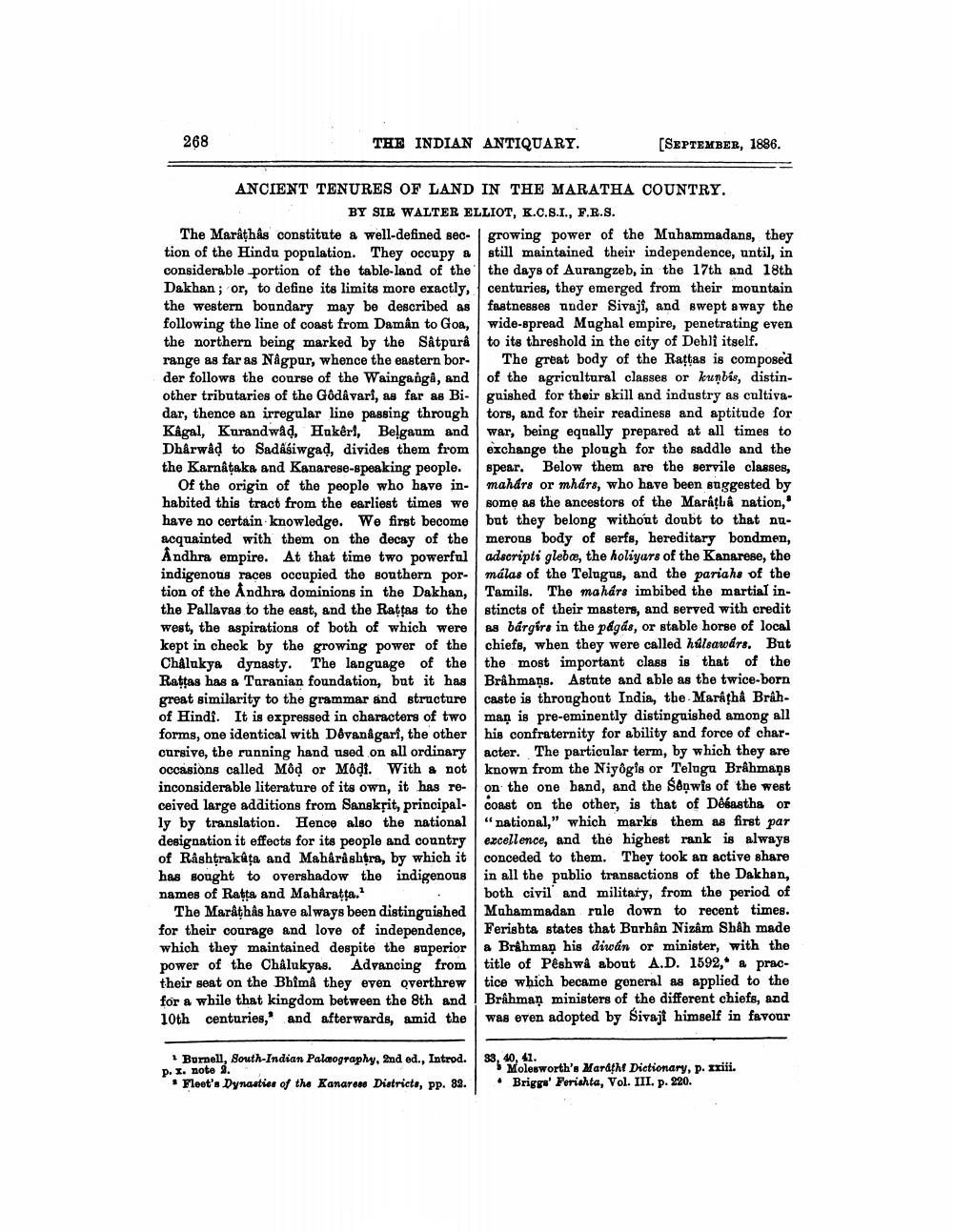________________
268
THE INDIAN ANTIQUARY.
[SEPTEMBER, 1886.
ANCIENT TENURES OF LAND IN THE MARATHA COUNTRY
BY SIR WALTER ELLIOT, K.C.S.I., F.R.S. The Markthâs constitute a well-defined sec- growing power of the Muhammadans, they tion of the Hindu population. They occupy a still maintained their independence, until, in considerable portion of the table-land of the the days of Aurangzeb, in the 17th and 18th Dakhan; or, to define its limits more exactly, centuries, they emerged from their mountain the western boundary may be described as fastnesses ander Sivaji, and swept away the following the line of coast from Daman to Goa, wide-spread Mughal empire, penetrating even the northern being marked by the Satpurâ to its threshold in the city of Debli itself, range as far as Nagpur, whence the eastern bor. The great body of the Rattas is composed der follows the course of the Wainganga, and of the agricultural classes or kunbís, distinother tributaries of the Godavari, as far as Bi- guished for their skill and industry as cultivadar, thence an irregular line passing through tors, and for their readiness and aptitude for Kågal, Kurandwad, Hakêri, Belgaum and war, being equally prepared at all times to Dharwad to Sadasiwgad, divides them from exchange the plough for the saddle and the the Karnataka and Kanarese-speaking people. spear. Below them are the servile classes,
Of the origin of the people who have in- mahars or mhárs, who have been suggested by habited this tract from the earliest times we some as the ancestors of the Maratlâ nation, have no certain knowledge. We first become but they belong without doubt to that nuacquainted with them on the decay of the merous body of serfs, hereditary bondmen, Andhra empire. At that time two powerful adscripti glebæ, the holiyars of the Kanarese, the indigenous races occupied the southern por- málas of the Telugus, and the pariahs of the tion of the Andhra dominions in the Dakhan, Tamils. The mahárs imbibed the martial inthe Pallavas to the east, and the Rattas to the stincts of their masters, and served with credit west, the aspirations of both of which were as bárgirs in the pagás, or stable horse of local kept in check by the growing power of the chiefs, when they were called halsawdrs. But Chålukya dynasty. The language of the the most important class is that of the Rattas has a Taranian foundation, but it has Brahmans. Astute and able as the twice-born great similarity to the grammar and structure caste is thronghout India, the Marathi Brahof Hindi. It is expressed in characters of two man is pre-eminently distinguished among all forms, one identical with Devanagari, the other his confraternity for ability and force of charcursive, the running hand used on all ordinary acter. The particular term, by which they are occasions called Môd or Modi. With a not known from the Niyôgis or Teluga Brahmans inconsiderable literature of its own, it has re- on the one hand, and the Seņwis of the west ceived large additions from Sanskrit, principal. coast on the other, is that of Débastha or ly by translation. Hence also the national "national," which marks them as first par designation it effects for its people and country excellence, and the highest rank is always of Rashtrakåta and Mahårå shtra, by which it conceded to them. They took an active share has sought to overshadow the indigenous in all the publio transactions of the Dakhan, names of Ratta and Mahâratta.
. both civil and military, from the period of The Markthâs have always been distinguished Muhammadan rule down to recent times. for their courage and love of independence, Ferishta states that Burhan Nizam Shah made which they maintained despite the superior a Brahman his diwán or minister, with the power of the Châlukyas. Advancing from title of Peshwå about A.D. 1592,* a practheir seat on the Bhimå they even overthrew tice which became general as applied to the for a while that kingdom between the 8th and Brahmaņ ministers of the different chiefs, and 10th centuries, and afterwards, amid the was even adopted by Sivajt himself in favour
Burnell, South Indian Palmography, 2nd ed., Introd. P. I. note 8.
• Fleet's Dynasties of the Kanaros Districts, pp. 82.
33, 40, 41.
Molesworth's Marathi Dictionary, p. xii. . Briggs' Forishta, Vol. III. p. 220.




